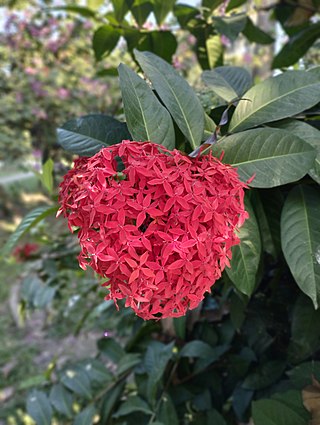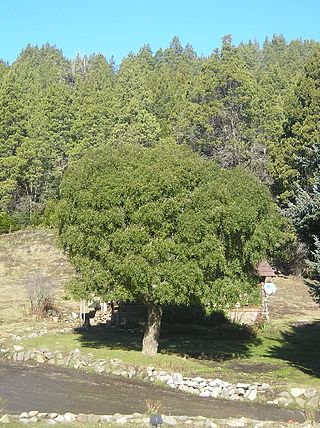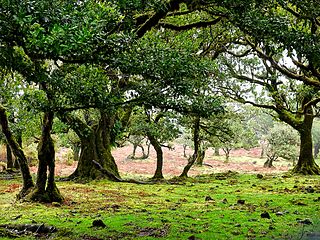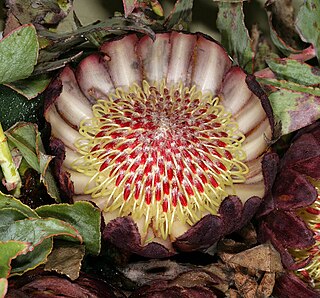
Knightia is a small genus of the family Proteaceae endemic to New Zealand, named in honor of Thomas Andrew Knight. One extant species, K. excelsa (rewarewa) is found in New Zealand. Two further Knightia species are found in New Caledonia, although they were placed in the genus Eucarpha by Lawrie Johnson and Barbara Briggs in their influential 1975 monograph "On the Proteaceae: the evolution and classification of a southern family", a placement supported in a 2006 classification of the Proteaceae. A fossil species from upper Miocene deposits in Kaikorai has been described as Knightia oblonga. Knightia has been placed in the tribe Roupaleae of the subfamily Grevilleoideae.

Ixora is a genus of flowering plants in the family Rubiaceae. It is the only genus in the tribe Ixoreae. It consists of tropical evergreen trees and shrubs and holds around 544 species. Though native to the tropical and subtropical areas throughout the world, its centre of diversity is in Tropical Asia. Ixora also grows commonly in subtropical climates in the United States, such as Florida where it is commonly known as West Indian jasmine.
Xenohyla truncata, the Izecksohn's Brazilian treefrog, is a species of frugivorous tree frog in the family Hylidae. It is endemic to the State of Rio de Janeiro, Brazil.

Maytenus is a genus of flowering plants in the family Celastraceae. Members of the genus are distributed throughout Central and South America, Southeast Asia, Micronesia, and Australasia, the Indian Ocean and Africa. They grow in a very wide variety of climates, from tropical to subpolar. The traditional circumscription of Maytenus was paraphyletic, so many species have been transferred to Denhamia and Gymnosporia.

Sideroxylon mirmulano, commonly known as marmulano, is a species of flowering plants in the family Sapotaceae. It is endemic to the Madeira Islands (Portugal). It is threatened by habitat loss.

Hypericum canariense is a species of flowering plant in the family Hypericaceae known by the common name Canary Islands St. John's wort. It is the sole member of Hypericumsect. Webbia.
Eucarpha is a genus of flowering plant of the family Proteaceae, endemic to New Caledonia. Two species are recognised. Up to 1975, these were classified within the genus Knightia until Lawrence Johnson and Barbara G. Briggs recognised their distinctness, particularly their prominent bracts, in their 1975 monograph "On the Proteaceae: the evolution and classification of a southern family". Nomenclatural combinations for these two species in the genus Eucarpha were published in 2022.
Dysoxylum crassum is a tree in the family Meliaceae. The specific epithet crassum is from the Latin meaning "thick", referring to the parts of the flowers.

The Southwestern Arabian foothills savanna, also known as the Southwestern Arabian Escarpment shrublands and woodlands, is a desert and xeric shrubland ecoregion of the southern Arabian Peninsula, covering portions of Saudi Arabia, Yemen, and Oman.
Crepinella acaropunctata is a flowering plant in the family Araliaceae. It is endemic to the tepuis Cerro Duida and Cerro Marahuaca in Duida–Marahuaca National Park of Amazonas state of southern Venezuela.
Heptapleurum stramineum is a species of flowering plant in the family Araliaceae. It is a scrambling tree endemic to Papua New Guinea.

The Madeira evergreen forests is a laurissilva ecoregion of southwestern Europe. It covers the archipelago of Madeira and some nearby islands in the Atlantic Ocean. Laurel forest, known as laurissilva, once covered the islands. Over centuries the laurel forests were mostly cleared. Madeira's remaining forests are now protected.

Sideroxylon canariense is a species of flowering plant in the family Sapotaceae. It It is endemic to the Canary Islands.

Protea amplexicaulis, the clasping-leaf sugarbush, is a flower-bearing shrub that belongs to the genus Protea. The plant is endemic to the Cape Provinces of South Africa and occurs from Citrusdal to the Kogelberg, as well as in the Langeberg. The shrub remains low and spreads out, becoming 1.3 m in diameter and flowering from June to September.
Garnotia cheesemanii, the Rarotongan garnotia grass, is a species of grass in the family Poaceae that is endemic to the island of Rarotonga in the Cook Islands in the South Pacific.

Polystichum drepanum, also known as Madeira shield-fern, is a species of fern in the Dryopteridaceae family.
Eucarpha deplanchei is a species of flowering plant in the family Proteaceae, native to New Caledonia. It was first described in 1865 as Knightia deplanchei.
Eucarpha strobilina, synonym Knightia strobilina, is a species of flowering plant in the family Proteaceae, native to New Caledonia.

Bryconops piracolina is a small fish that inhabits the waters of Brazil. It is slender and silvery in color, like many fish in Bryconops, but can be distinguished from other members by way of its dorsal fin, which has a black patch of color extending up from the fin-base; congeners usually have light pigment in the dorsal fin, or a brighter color.
Analavelona, also known as Analavelona Massif, is a mountain in southwestern Madagascar. The massif is home to an enclave of montane subhumid forest, which is considered a sacred forest by the local people and notable for its biodiversity.











